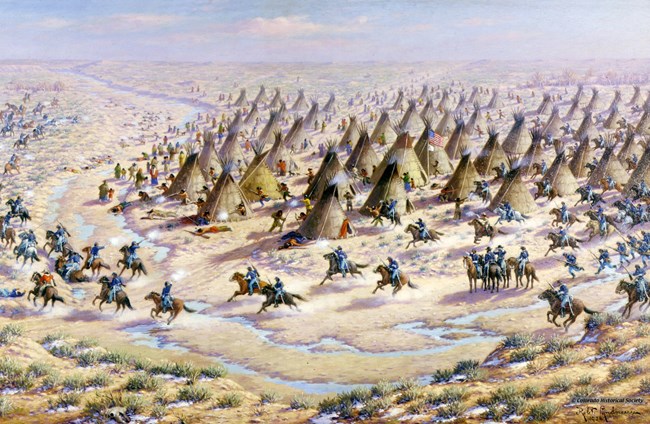
- Details
- By Native News Online Staff
THIS DAY IN HISTORY - On November 29, 1864, seven hundred members of the Colorado Territory militia embarked on an attack of Cheyenne and Arapaho Indian villages. The militia was led by U.S. Army Col. John Chivington, a Methodist preacher, as well as a freemason. After a night of heavy drinking by the soldiers, Chivington ordered the massacre of the Indians. Over two-thirds of the slaughtered and maimed were women and children. This savage atrocity has been known as the Sand Creek Massacre ever since.
While the exact number of American Indians killed that day varies, award-winning historian Alan Brinkley wrote that 133 Indians were killed, 105 of whom were women and children.
For years, the United States had been engaged in conflict with several Indian tribes over territory. The Treaty of Fort Laramie in 1851 had given the Indians extensive territory, but the Pikes Peak gold rush in 1858 and other factors had persuaded the U.S. to renegotiate the terms of the treaty. In 1861, the Treaty of Fort Wise was signed by Southern Cheyenne and Arapaho chiefs. The treaty took from the Indians much of the land given to them by the earlier treaty, reducing the size of their reservation land to about 1/13th of the original amount.
Although the peace seeking chiefs signed the treaty to ensure the safety of their people, not all of the tribes were happy with the decision. In particular, a group of Indians known as the Dog Soldiers, made up of Cheyenne and Lakota, were vehemently opposed to having white settlers on what the Indians still referred to as their land.
In 1864, a group of Civil War soldiers under Chivington, with the blessing of Colorado governor John Evans, began to attack several Cheyenne camps in Colorado. Another attack on Cheyenne camps occurred in Kansas by forces under the command of Lieutenant George S. Eayre. The Cheyenne retaliated for the attack, furthering the aggression of the U.S. forces.
In an attempt to maintain peace, two chiefs, Black Kettle and White Antelope, tried to establish a truce. They were advised to camp near Fort Lyon in Colorado and fly an American flag over their camp to establish themselves as friendly.
More Stories Like This
Native News Weekly (August 25, 2024): D.C. BriefsUS Presidents in Their Own Words Concerning American Indians
Native News Online Launches Year-End Campaign to Support ‘Warrior Journalism’
Native News Online’s Year-End Live Stream - Recap of 2025: A Night That Brings Indian Country Together
GivingTuesday: Groups Making a Real Impact in Indian Country
Help us tell the stories that could save Native languages and food traditions
At a critical moment for Indian Country, Native News Online is embarking on our most ambitious reporting project yet: "Cultivating Culture," a three-year investigation into two forces shaping Native community survival—food sovereignty and language revitalization.
The devastating impact of COVID-19 accelerated the loss of Native elders and with them, irreplaceable cultural knowledge. Yet across tribal communities, innovative leaders are fighting back, reclaiming traditional food systems and breathing new life into Native languages. These aren't just cultural preservation efforts—they're powerful pathways to community health, healing, and resilience.
Our dedicated reporting team will spend three years documenting these stories through on-the-ground reporting in 18 tribal communities, producing over 200 in-depth stories, 18 podcast episodes, and multimedia content that amplifies Indigenous voices. We'll show policymakers, funders, and allies how cultural restoration directly impacts physical and mental wellness while celebrating successful models of sovereignty and self-determination.
This isn't corporate media parachuting into Indian Country for a quick story. This is sustained, relationship-based journalism by Native reporters who understand these communities. It's "Warrior Journalism"—fearless reporting that serves the 5.5 million readers who depend on us for news that mainstream media often ignores.
We need your help right now. While we've secured partial funding, we're still $450,000 short of our three-year budget. Our immediate goal is $25,000 this month to keep this critical work moving forward—funding reporter salaries, travel to remote communities, photography, and the deep reporting these stories deserve.
Every dollar directly supports Indigenous journalists telling Indigenous stories. Whether it's $5 or $50, your contribution ensures these vital narratives of resilience, innovation, and hope don't disappear into silence.
 The stakes couldn't be higher. Native languages are being lost at an alarming rate. Food insecurity plagues many tribal communities. But solutions are emerging, and these stories need to be told.
The stakes couldn't be higher. Native languages are being lost at an alarming rate. Food insecurity plagues many tribal communities. But solutions are emerging, and these stories need to be told.
Support independent Native journalism. Fund the stories that matter.
Levi Rickert (Potawatomi), Editor & Publisher

